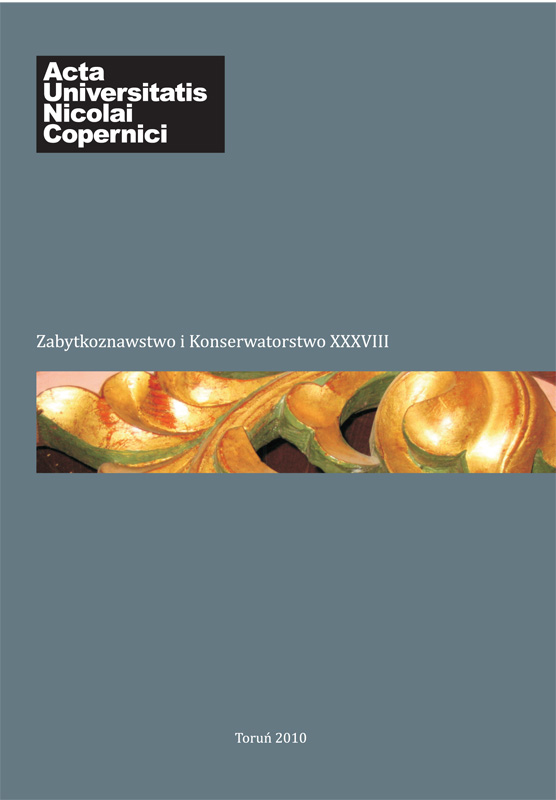Badania materiałów stosowanych do uzupełniania ubytków zapraw w malowidłach na płótnie
DOI:
https://doi.org/10.12775/AUNC_ZiK.2010.006Abstrakt
The paper presents the description and results of the research on materials used or potentially suitable for reintegration of the injuries of priming in paintings on canvas. Five ready-made brand products have been tested and compared them with two products made by the recipes aiming for determination of their physical and chemical properties as well as suitability in conservation of easel paintings on canvas supports.
The following research procedures were followed: the analysis of chemical composition – using Differential Thermal Analysis (DTA) as well as IR-spectroscopy; the evaluation of preparation, application and other of handling properties; suitability for imprinting the texture on the surface of fi lling using negative moulds of artifi cial resins; evaluation of shrinkage and cracking during drying of the material applied to canvas support; the adhesion to canvas sized with methyl cellulose and saturated with bees-wax-and resin mixture; determination of pH of fresh, cured and aged materials; elasticity of fi llings on canvas bent on cylinders of various diameter in different humidity and temperature conditions; hygroscopic properties in high humidity atmosphere; absorbability and wettability of the fi lling surface with aqueous binding media of paints; adhesion of layers of paints with water-based media resistance to biodegradation in high humidity atmosphere; ageing resistance in extreme air temperature and humidity; reversibility – the possibility to remove the fi llings after several months of aging in extreme air temperature and humidity – with mechanical and chemical methods.
Pobrania
Opublikowane
Jak cytować
Numer
Dział
Licencja
CC BY-ND 4.0. Posiadaczem prawa autorskiego (Licencjodawcą) jest Autor, który na mocy umowy licencyjnej udziela nieodpłatnie prawa do eksploatacji dzieła na polach wskazanych w umowie.
- Licencjodawca udziela Licencjobiorcy licencji niewyłącznej na korzystanie z Utworu/przedmiotu prawa pokrewnego w następujących polach eksploatacji: a) utrwalanie Utworu/przedmiotu prawa pokrewnego; b) reprodukowanie (zwielokrotnienie) Utworu/przedmiotu prawa pokrewnego drukiem i techniką cyfrową (e-book, audiobook); c) wprowadzania do obrotu egzemplarzy zwielokrotnionego Utworu/przedmiotu prawa pokrewnego; d) wprowadzenie Utworu/przedmiotu prawa pokrewnego do pamięci komputera; e) rozpowszechnianie utworu w wersji elektronicznej w formule open access na licencji Creative Commons (CC BY-ND 4.0) poprzez platformę cyfrową Wydawnictwa Naukowego UMK oraz repozytorium UMK.
- Korzystanie przez Licencjobiorcę z utrwalonego Utworu ww. polach nie jest ograniczone czasowo ilościowo i terytorialnie.
- Licencjodawca udziela Licencjobiorcy licencji do Utworu/przedmiotu prawa pokrewnego nieodpłatnie na czas nieokreślony
PEŁEN TEKST UMOWY LICENCYJNEJ >>
Statystyki
Liczba wyświetleń i pobrań: 1625
Liczba cytowań: 0



